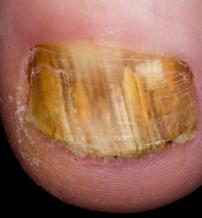Laser treatment of onychomycosis

Clinical symptoms
Fungi like moist, warm, dark environments, so they can be found in swimming pools and gyms, among others. Anyone's nails can become infected, but the following increase the risk of infection: diabetes, arteriosclerosis, immune supression, old age, nail plate damage, tight or wearing poorly ventilated footwear, playing sports, wearing artificial nails, previous onychomycosis. At first, only a little yellowish, brownish, or less often, a whitish discoloration can be observed on the surface of the nail plate. Over time, the nail plate thickens, crumbles, deforms, can separate from the nail bed, and sometimes the nail does not even grow. On the toes, it starts at the free edge of the nail and moves towards the upper nail fold, eventually affecting the entire nail plate. Without treatment, it can spread to other nails and infect people who come into contact with it. Its frequency is 2-14%, 90% of cases occur on toenails, half of nail diseases are fungal. The deformed, thickened nail can be painful, make it difficult to wear shoes, and cause an unpleasant smell. Onychomycosis does not go away without treatment. Onychomycosis can play a role in the development of many diseases: ingrown toenail, eczema, ringworm, lymphadenopathy and varicose veins.
It is the task of a dermatologist to judge whether a nail abnormality is caused by fungus! Choosing the treatment for onychomycosis is also a dermatologist's task!
At our private practice, onychomycosis is treated with Q-switched Nd YAG and KTP lasers
What are the benefits of treating onychomycosis with Q-switched lasers for you?
- Fast, painless.
- Safe, free of side effects.
- More effective (80-90%) than any other treatment.
- Taking medication lasts a long time (3-9 months).
- There are no age or medication restrictions.
- Taking medication can cause drug interactions.
- Taking medication can cause side effects (liver and kidney damage, abdominal complaints, headache).
- Combined, Q-switched Nd YAG and KTP laser treatment of onychomycosis is only required twice.
- Local treatment is difficult, lasts 10-12 months, has a low degree of effectiveness, and is only effective in cases affecting a small part of the nail.
Based on the above, the first method of choice for you is the combined Q-switched Nd YAG and KTP laser treatment of onychomycosis.
How do Q-switched lasers work when treating onychomycosis?
Q-switched lasers emit short, high-energy pulses. The light of the KTP laser is absorbed by the surface of the nail. The light of the Nd YAG laser penetrates deeper, passing through the nail plate and reaching the fungi in the nail bed. The light of the lasers is absorbed exclusively in the pigment and cell wall of the fungi. Thus, it destroys the fungi without damaging the surrounding tissues. Laser treatment also destroys the fungal spores responsible for re-infection, thus providing longer-term results than other treatments.
What do you need to do before treating onychomycosis with Q-switched lasers?
Before the treatment, remove the nail polish, thins the thickened nail plate to a thickness of 1-2 mm.
How do we perform the Q-switched laser treatment of onychomycosis?
The treatment does not require anesthesia. We scan the entire nail plate and nail folds with the light of the laser. The treatment lasts 5-20 minutes, depending on the number of nails treated. Meanwhile, you feel no pain, only slight warmth or tingling. The treatment is repeated after in a week. We wait the patient for a control examination in 3-4 months, if necessary, we perform a repeat treatment.
What should you do after treating onychomycosis with Q-switched lasers?
After the treatment, you do not need additional treatment, you can immediately return to your usual daily activities. If you wish, you can paint your nails again immediately after the procedure.
What discomforts can you experience after treating onychomycosis with Q-switched lasers?
According to experience, there are no side effects or complication after the combined, Q-switched Nd YAG and KTP laser treatment.
What happens after treating onychomycosis with Q-switched lasers?
Immediately after the treatment, you will not notice any change in the appearance of the nail. The nails grow slowly, on the feet after 2-3 months the new, healthy nail plate becomes visible at the upper nail fold, the total time for the nail to grow out is 9-12 months.
When do we not perform onychomycosis treatment with Q-switched lasers?
Fungal infection of the fingernails is caused by Candida, in which case laser treatment is not effective. We also do not perform treatment in case of pregnancy or unrealistic expectations from the patient.
After the treatment, you will receive detailed, written advice to prevent the recurrence of onychomycosis.
Visit: 33 000 HUF
Treatment price:
1 nail / occasion: 10 000 HUF
2 nails / occasion: 16 000 HUF
3-5 nails / occasion: 20 000 HUF
6-10 nails / session: 25 000 HUF

